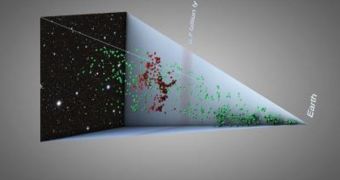The “Cosmic Web” is a concept that is often used to refer to the underlying support structure that our Universe has, which we cannot see with our eyes or scientific instruments but know it's there. This web, which is charged with keeping galaxies together, and at times channelling them into superclusters, is entirely made up of dark matter, according to the standard cosmological matter. Now, a new series of spectroscopic observations looked at over 150 galaxies, using two of the world's best telescopes to obtain a 3D view of their spatial arrangement. The investigation may hold clues to deciphering some of the mysteries associated with the early composition and matter distribution in the Cosmos.
“Matter is not distributed uniformly in the Universe. In our cosmic vicinity, stars form in galaxies and galaxies usually form groups and clusters of galaxies. The most widely accepted cosmological theories predict that matter also clumps on a larger scale in the so-called 'cosmic web,' in which galaxies, embedded in filaments stretching between voids, create a gigantic wispy structure,” European Southern Observatory (ESO) expert Masayuki Tanaka believes.
The expert has also been the leader of the new spectroscopic study, which used the IMOS instrument on ESO's Very Large Telescope, in Chile, and the FOCAS instrument, on the Subaru Telescope. The latter observatory is being operated by the National Astronomical Observatory of Japan.
The study fills a gap in astronomical knowledge that has persisted for many years. While experts continuously discover filamentary structures created by dark matter, or at least infer them, around the Milky Way, this has never before been accomplished for very distant galaxies and clusters.
According to the team, the previously unknown assembly of galaxies that made the target of the new research is located almost seven billion light-years away from the Earth. Because of the spatial disposition of the two telescopes, the images that were obtained – when combined – were three-dimensional. This was owed to the fact that they were taken from two different perspectives, and then superimposed. The accomplishment allowed the astronomers to identify several groups of galaxies around the main cluster, something that had not been noticed before.
“This is the first time that we have observed such a rich and prominent structure in the distant Universe, We can now move from demography to sociology and study how the properties of galaxies depend on their environment, at a time when the Universe was only two thirds of its present age,” Tanaka concludes.

 14 DAY TRIAL //
14 DAY TRIAL //